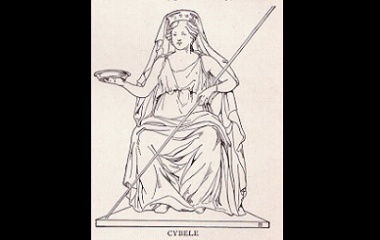- Pronunciation: ki-ve-li
- Origin: Anatolia
- Powers: Controls all life
- Other names: Kubeleya, Kybele
Everyone loves their mothers, but Cybele is perhaps the greatest mother of all. She was loved throughout much of the Hellenistic (ancient Greek) period. Cybele is a much-travelled deity and it seems love for her transcended many cultural boundaries, as people of very different backgrounds all embraced her.
Who Is Cybele?
Cybele is a great ancient goddess who originally hails from a part of the world known as Anatolia. Today, much of what was Anatolia is in the nation of Turkey. The people of Anatolia who worshipped her were known as the Phrygians, and were mainly mountain-dwellers.
Cybele’s main attribute is that she is a mother. Rather, one could say that she is THE mother. Eventually, she came to be seen as the mother of all gods and, ultimately, all life. That’s a big job, so hopefully she got a truckload of Mother’s Day cards every year.
As the mother of all life, Cybele would control fertility and all aspects of natural life, from plants to animals. All living things were her subjects. In her original Anatolian guise, Cybele is also seen as a teacher of mankind and a guide to the world and those who live in it.
Since Anatolia had such harsh mountain wildernesses, the people there had great respect for the power of nature. Cybele was seen as the one who decided whether mankind was spared the full might of nature. As such, she became known as the protector of civilization and cities, as long as they worshipped and respected her.
Appearance
Since Cybele has been around for such a long time and has been adopted by so many cultures, her appearance in carvings, murals, paintings and writing has changed over time.
The earliest sculptures mentioning her were found in Anatolia and show a female figure giving birth on a throne. The woman is large and portly; this is typical of how fertility gods are depicted in cultures across the world.
Later images show her as a motherly yet handsome woman in fine clothes. Often, she is shown with a pregnant belly. Cybele is associated with a number of mountain animals, such as the lion and the hawk. Her chariot, for example, is drawn by lions. When she is shown on her throne, many of her attendants are wild animals.
Family
Figuring out exactly what Cybele’s family tree looks like is a very tricky prospect. In her original Anatolian form, it is not clear who her parents are, but it seems as if the god of the sky and goddess of the earth may have birthed Cybele.
The Greeks interpreted these figures as being Zeus and Gaia respectively. Zeus is, of course, the prime Olympian god, and Gaia Titaness, which makes Cybele a half-Titan from the Greek point of view.
Other stories describe her as “uncreated” and without parents, which is probably closer to the original origin story of her life.
Origin
There aren’t all that many stories about Cybele that would qualify as proper myths and, as previously mentioned, she is most likely “uncreated”, having always been there. One account of her origins states that she was born a hermaphrodite, but was then castrated by other gods. The theme of castration is one that manifests in many ways within the Cybele mythos.
There is, however, one well-known story about the goddess that puts her feet firmly on the earth among humans in a way that is typical of myths.
The story goes that Cybele was once in love. The object of her affection was a mortal shepherd named Attis. Unfortunately, Attis had eyes for others besides Cybele, and cheated on the goddess.
It turns out that cheating on a being with power over all life is not a very smart move. As punishment, Cybele drove Attis insane. This madness drove him to kill himself in a strangely appropriate way: by castrating himself. This is probably also the reason that the Cult of Cybele’s priests would castrate themselves later, as a form of devotion to the goddess.
Cybele regretted Attis’s death deeply and went into mourning. This was when death was introduced to the world. She then apparently remembered that she was goddess of all life and resurrected Attis, bringing all of nature back to life in the process.
History
Cybele is most likely a more refined version of early Phrygian mother goddesses. Artwork dating back to around the 8th century shows the plump figure of a traditional fertility goddess sitting on a lion-headed throne. Already at this point we see associations with lions, birds of prey and other wild animals.
The Phrygian cults spread the Cybellan beliefs to Anatolia as a whole and the rest of Greece. She gets a high position in the Greek pantheon as a daughter of Zeus and Gaia, but at first this foreign cult was met with violent opposition by other Greek religious groups.
Cybele found her way to Rome much the same way that other Greek gods did. Here, her Galli priesthood also became established. When Rome changed from a republic to an empire, Cybele as the Magna Mater or “Great Mother” became a major symbol of the empire.
In Pop Culture
In one episode of the hit TV series Plebs, the character Grumio accidentally joins the Cult of Cybele, only to escape as fast as he can when he finds out that he must be castrated to become a member.










